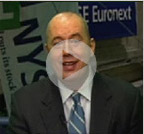Contrary to many people’s expectations, the Federal Reserve refrained last month from raising the interest rate over which it has fairly direct control. That means we can expect several more months of debate over (I’ll simplify slightly) whether the world will end if the Fed raises rates too soon, or if it waits too long.
There are two odd things about this debate. The first is that proponents of an interest-rate increase generally treat it as an end in itself. The second is that a tiny increase in the federal funds rate should be thought to be so important either way.
Typically, the central bank raises interest rates to tame inflation. But the inflation rate has run below the Fed’s 2 percent target for years, and market expectations, as best they can be measured, suggest it will remain low for years to come. So most of the arguments for increasing rates haven’t focused on consumer prices. Instead the line is that the Fed should raise rates because they’ve been unnaturally low for too long, and it’s time to “normalize” them.
The assumption is that the Fed has intervened in the market by maintaining a “zero interest rate policy,” that this is a highly accommodative policy, and that the Fed should now retreat to a more modest role. Raising rates would have the added benefit of helping savers who have been punished with low returns for years. Sometimes it is added that these artificially low rates have inflated asset bubbles.
Ben Bernanke, the former chairman of the Fed, has explained why these assumptions are mistaken. The main reason interest rates have been so low since the financial crisis of 2008 isn’t because the Fed is holding them low, but because the “natural” or “equilibrium” interest rate has been lower still thanks to the weakness of the economy. Trying to raise interest rates, Bernanke argues, would have been just as much of an intervention in the economy as keeping them low -- and one that ultimately would’ve left savers worse off. Hiking rates prematurely would have hurt the economy, thereby driving returns lower and forcing the Fed to engage in more stimulative policies.
Many people think that low interest rates are a sign of loose or expansive monetary policy, but they need not be. The Fed is now generally considered to have been much too restrictive in the early 1930s, but interest rates were very low. They were low because tight money had caused an economic contraction. Bernanke’s points about interest rates raise the possibility that the Fed hasn’t been nearly as accommodative in recent years as most people think. Perhaps -- although he himself doesn’t draw this conclusion -- it has even been too tight.
Either way, you might wonder why markets have gotten so worked up over every hint from the Fed about what it plans to do. The main action under consideration, after all, is a mere quarter-point increase in the federal funds rate. Is our economy really so fragile that such a modest change would be disruptive?
It’s unlikely that the direct effects would make a huge difference. But that’s not the whole story. The Fed doesn’t follow a simple rule in setting its policies. It doesn’t say, for example, that it will loosen policy whenever market expectations of average inflation rates over the next five years fall below 1.5 percent, and tighten whenever they rise above 2.5 percent. When it tells the world its intentions, it is deliberately opaque. That makes its conduct hard to predict, and puts a premium on evidence of its true goals.
Raising the federal funds rate 25 basis points with the inflation rate so low would be powerful evidence about the general mindset at the Fed -- about how worried its members are that they’ve been too accommodative, about how they weigh the risks of tightening, about their willingness to hold rates low for years after a future crisis. Tightening current policy would signal that future policy will also be tighter, compared to a world where the Fed declines to raise rates.
It would also mean that the Fed thinks the key question for monetary policy now is, “When do we finally get to raise interest rates?” It’s not irrational for markets to worry about that.








